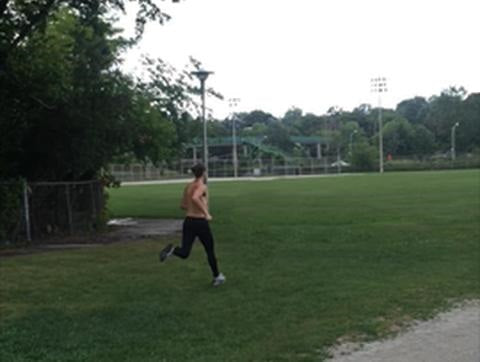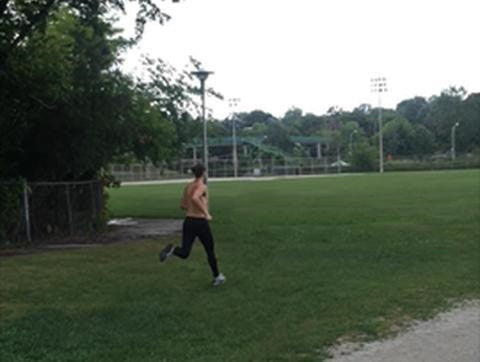
Canadian National athlete Dan Brady completing a 2 x 600m breakdown
at Riverdale Park August 2016
Tempo for Speed Training
Tempo running is defined as running performed at 65 – 75% percent of one’s maximum speed. What is important on how to perform tempo is you want the last rep of your runs to be the same speed as the first runs. For example, if you are not able to complete 10 repetitions of 100 meters at an even speed, start with a shorter distance and improve that distance over a few weeks. You might also try slowing the overall speed down. To improve the quality of your tempo running monitor by hand timing your runs and making sure you are consistent with short breaks.
FACTS regarding tempo running for speed training
- A wide range of people with varied ages and skills will be able to benefit from tempo for speed training. There are also many ways to perform tempo versus just the running version which you can see in the GPP (General Preparation Phase) download. Examples are pool tempo (see Project Jane download), bike tempo (bike workout download) and indoor matt running (basement tempo download).
- If you are a speed and power athlete who has not been performing tempo runs 2 to 3 x per week, adding in these cardiovascular building runs into your training will facilitate improved capillary density which indirectly increases blood flow which improves recovery. (Note: you will need to take something out of your current training plan to add more into it)
- 75% of top speed is the upper limit, in the same conditions as your best time for the distance. Adjust the effort level to suit conditions - long grass, short grass, smooth, bumpy ground etc. It’s a preferred practice to do all tempo on grass if possible in flats not spikes – this means you adjust pace downwards.
- Tempo aids in recovery and the ability to stay warm between reps and sets. It can have an indirect role in speed development by increasing the muscles’ ability to generate more heat.
- Typically the session volume would be as follows:
100 – 200 meter specialist – 2000 meter per session 3 x per week
400 meter specialist - 3000 meter per session 3 x per week
800 meter specialist – 4000 meters per session 3 x per week
- Upper limit is 75% effort levels over distances of 100 – 400 m per repetition. Although the volume of each session would adhere to the above guidelines the length of each rep would result in different training effects.
- Above 200m distances could produce too much lactate for sprinters of early training age or trained inappropriately to handle. You need to gradually build up the distances and intensities so that lactic is not a problem along the way.
- SPRINTING AND TEMPO running can coexist fine in any training program as the tempo running is so low in intensity that it does not effect the CNS (Central Nervous System) and because the total volume of tempo work is small. (2000 m per session)
- AEROBIC TRAINING interferes with speed and strength development when the volume gets out of hand. In small quantities it’s fine and even enhances the speed and power development through recovery.
- Different types of tempo for different purposes
Tempo performed in The General Preparation Phase of training (GPP) will be different than all other phases of training, which include SPP and pre competition and competitive season training.
Two different types of tempo performed during GPP
1. EXTENSIVE TEMPO
Extensive tempo are low intensity with incomplete recovery. Performing tempo in this way serves to flush out the system of impurities like lactic acid and promotes CNS recovery and promotes cardio fitness. FACT = extensive tempo can replace continuous runs even for the 800m+ distances.Examples of Extensive tempo would be Big and Small Circuits or repeat 100’s.
Big Circuit (big Tempo Circuit ) add 00’s
1+1+1
1+1+2+1
1+2+2+1
1+2+1+1
1+1+1
walk 50m between reps
walk 100m between sets
(we used a football field length wise, marked 25 m, walked back and performed the runs in this way)
2. INTENSIVE TEMPO
More intense runs than extensive tempo and not recovery work but used in the early stages of a speed development program and definitely not during the competitive phase of the season. This type of tempo is only used during GPP as it creates lactic acid and might be confused with what coach Charlie Francis discusses as medium work. The breaks are still short. In GPP intensive tempo is done for foundation of overall fitness.Examples of Intensive tempo would be 7 to 10 x 300 with 4 to 5 min rest reducing recovery length over time or 600 breakdowns x 1 or 2 .
NOTES
Here’s an interesting note from Coach Charlie Francis in Forums from 2002 to 2004 “In later stages 100 meter sprinter Ben Johnson (born Dec 30 1961) did not go past 300 m in tempo. (Ben told the author that he performed 300’s and further distances from 1977 to 1983) but he did sessions of 10 x 300 in 45 to 48 seconds with a 100 m walk recovery. Earlier still he did 600 m breakdowns (6,5,4,3, 2,1) with walk equal to distance recoveries for tempo work in early season.An example of how the author performed tempo running year around during competition was to do varied tempo distances 2 to 3 x per week alternating with Speed and Power work performed 2 to 3 x per week. Typically speed and power work together on Mondays, Wednesday and Fridays. Tempo and recovery work we would do Tuesdays and Thursdays and Saturdays. A tremendous amount of variability might exist from individual to individual and day to day in terms of how much volume performed. It would depend on how the adaptation happens daily and cumulatively over each training block annually.
INTENSIVE tempo performed during other parts of a season such as pre comp and comp when quality needs to be first and rest intervals long and complete will create the opposite effect for an athlete as I have discussed above. For further reading go to Amazon and look at the Key Concept Books series of books and Speed Trap. For an extensive overview check out the charliefrancis.com site for the Vancouver Seminar 1 and 2 series.
There is more to discuss about tempo but this blog will give your more than what you need to experiment as a beginner or elite athlete.
I am always around to answer questions. Curious minds learn more.
best,
Angé


5 comments
Leia,
No need to be confused about tempo and resist the 10 mile long articles about tempo.
One of Master Coach Charlie Francis’s athletes told me she explained tempo as “recovery running”. I thought that explanation was brilliant Cheryl T.
You want to be able to complete the workout as you began it. I am referring to the pace and effort and level of difficulty. I think performing tempo is tough to do alone if you don’t know what you are doing. If you like please contact me directly and perhaps a discussion to explain may help you.
A workout that says
100-200-100 means you would be running 100meters at low intensity, walk 50 meters and then run 200meters same speed and intensity, walk 50m and then complete the final run of this set with running 100meters.
This set represents one set of other sets in the Small or Big Circuit.
In wich book of charlie francis can we find the most document Tempo running programm?
Thanks
Im still a little confused on the extensive tempo. If i see a workout that says 100-200-100 how would that workout look?
Get rid of the word “should”, first off.
According to Coach Charlie Francis, it was daily speed work and high intensity training that lead to career ending injuries before he was able to realize his full potential.
Extreme frustration lead him to question why he had to quite track before he was 24 years old.
Enter National Team coach Gerhard Mach along with Charlie’s unrelenting desire to have different for his athletes and this is how he came to start using low intensity runs on off days.
To be safe, some people like to use 60% max speed for recovery runs (aka tempo) in-between speed sessions. In the beginning, athletes and coaches are not always sure how to run tempo. On the grass, in flats and relaxed is how you need to think of these runs.
At times we used easy exercises in place of tempo or swimming lengths with running in the pool. Generally speaking, tempo is heaviest in the fall and spring in NON competitive seasons. We did tempo all year around but it changed according to the weather and training block.
There has been a great deal of discussion on needing tempo and not needing tempo. It builds your cardio fitness, it vascularizes muscles for improved blood flow, and it helps facilitate speed work by keeping muscles loose.
I hope my comments help you understand tempo runs a bit more.
“Sprint your own race”
Coach Angé
Should the offseason consist of Intensive tempo on Mondays,Wednesdays, and Fridays and then Extensive tempo on Tuesdays and Thursdays and Saturday? W/ altering based on how taxed your body feels